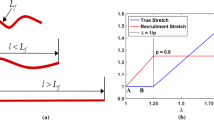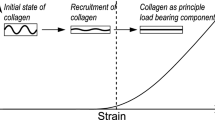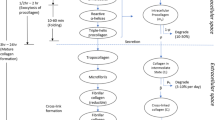Abstract
The passive biomechanical behavior of blood vessels is generally modeled by a parallel arrangement of elastin and collagen, with collagen recruitment depending on vessel strain. We experimentally determined the collagen recruitment distribution using confocal microscopy. Digital images from sections of rabbit carotid artery under increasing circumferential stretch ratio were acquired. The straightness of the fibers was measured to compute the fraction of recruited fibers for each stretch ratio. The experimental distribution obtained was then used in the model proposed by Zulliger et al. This model is based on a strain energy function (SEF), which provides a constituent-based description of the wall mechanics. Using this model, a fit of the pressure–radius curve was then performed by using the experimental collagen recruitment distribution with the collagen elastic constant as a free fit parameter. The fit was good, but the value of the collagen elastic constant obtained was below values reported in the literature. A second fit of the pressure–radius curve was also performed, whereby the collagen distribution was left free to adapt while the collagen elastic constant was set to a physiological value. The differences between the experimental collagen engagement distribution and the distribution obtained when the collagen elastic constant was fixed were analyzed. Good qualitative agreement was found between the experimental distribution of collagen recruitment and the model. Some experimental limitations and modeling approximations remain. Nevertheless, experimental proof of progressive collagen recruitment was established, which validates the basic hypothesis of the model.










Similar content being viewed by others
References
Dobrin PB. Mechanical properties of arteries. Physiol Rev. 1978;58:397–460.
Zulliger MA, Fridez P, Hayashi K, Stergiopulos N. A strain energy function for arteries accounting for wall composition and structure. J Biomech. 2004;37:989–1000.
Han HC, Fung YC. Longitudinal strain of canine and porcine aortas. J Biomech. 1995;28:637–41.
Fung YC. Biomechanics: mechanical properties of living tissue. New York: Springer-Verlag; 1993.
Montes GS. Structural biology of the fibres of the collagenous and elastic systems. Cell Biol Int. 1996;20:15–27.
Bergel DH. The static elastic properties of the arterial wall. J Physiol. 1961;156:445–57.
VanDijk AM, Wieringa PA, van der Meer M, Laird JD. Mechanics of resting isolated single vascular smooth muscle cells from bovine coronary artery. Am J Physiol. 1984;246:C277–87.
Wuyts FL, Vanhuyse VJ, Langewouters GJ, Decraemer WF, Raman ER, Buyle S. Elastic properties of human aortas in relation to age and atherosclerosis: a structural model. Phys Med Biol. 1995;40:1577–97.
Spencer AJM. Continuum mechanics. Essex: Longman Scientific & Technical; 1980.
Clark JM, Glagov S. Transmural organization of the arterial media. The lamellar unit revisited. Arteriosclerosis. 1985;5:19–34.
Dingemans KP, Teeling P, Lagendijk JH, Becker AE. Extracellular matrix of the human aortic media: an ultrastructural histochemical and immunohistochemical study of the adult aortic media. Anat Rec. 2000;258:1–14.
Decraemer WF, Maes MA, Vanhuyse VJ. An elastic stress-strain relation for soft biological tissues based on a structural model. J Biomech. 1980;13:463–8.
Wolinsky H, Glagov S. Structural basis for the static mechanical properties of the aortic media. Circ Res. 1964;14:400–13.
Zulliger MA, Rachev A, Stergiopulos N. A constitutive formulation of arterial mechanics including vascular smooth muscle tone. Am J Physiol Heart Circ Physiol. 2004;287:H1335–43.
Rezakhaniha R, Stergiopulos N. A structural model of the venous wall considering elastin anisotropy. J Biomech Eng. 2008;130:031017.
Roy S, Tsamis A, Prod’hom G, Stergiopulos N. On the in-series and in-parallel contribution of elastin assessed by a structure-based biomechanical model of the arterial wall. J Biomech. 2008;41:737–43.
Fonck E, Feigl G, Augsburger L, Rüfenacht D, Stergiopulos N. Biomechanical study of structural changes of human cerebral arteries. J Biomech. 2006;39:S364.
Zulliger MA, Stergiopulos N. Structural strain energy function applied to the ageing of the human aorta. J Biomech. 2007;40:3061–9.
Tsamis A, Stergiopulos N. Arterial remodeling in response to hypertension using a constituent-based model. Am J Physiol Heart Circ Physiol. 2007;293:H3130–9.
Bank AJ, Wang H, Holte JE, Mullen K, Shammas R, Kubo SH. Contribution of collagen, elastin, and smooth muscle to in vivo human brachial artery wall stress and elastic modulus. Circulation. 1996;94:3263–70.
Cox RH. Regional variation of series elasticity in canine arterial smooth muscles. Am J Physiol. 1978;234:H542–51.
Author information
Authors and Affiliations
Corresponding author
Additional information
S. Roy and C. Boss contributed equally to this work.
About this article
Cite this article
Roy, S., Boss, C., Rezakhaniha, R. et al. Experimental characterization of the distribution of collagen fiber recruitment. J Biorheol 24, 84–93 (2010). https://doi.org/10.1007/s12573-011-0027-2
Received:
Accepted:
Published:
Issue Date:
DOI: https://doi.org/10.1007/s12573-011-0027-2




